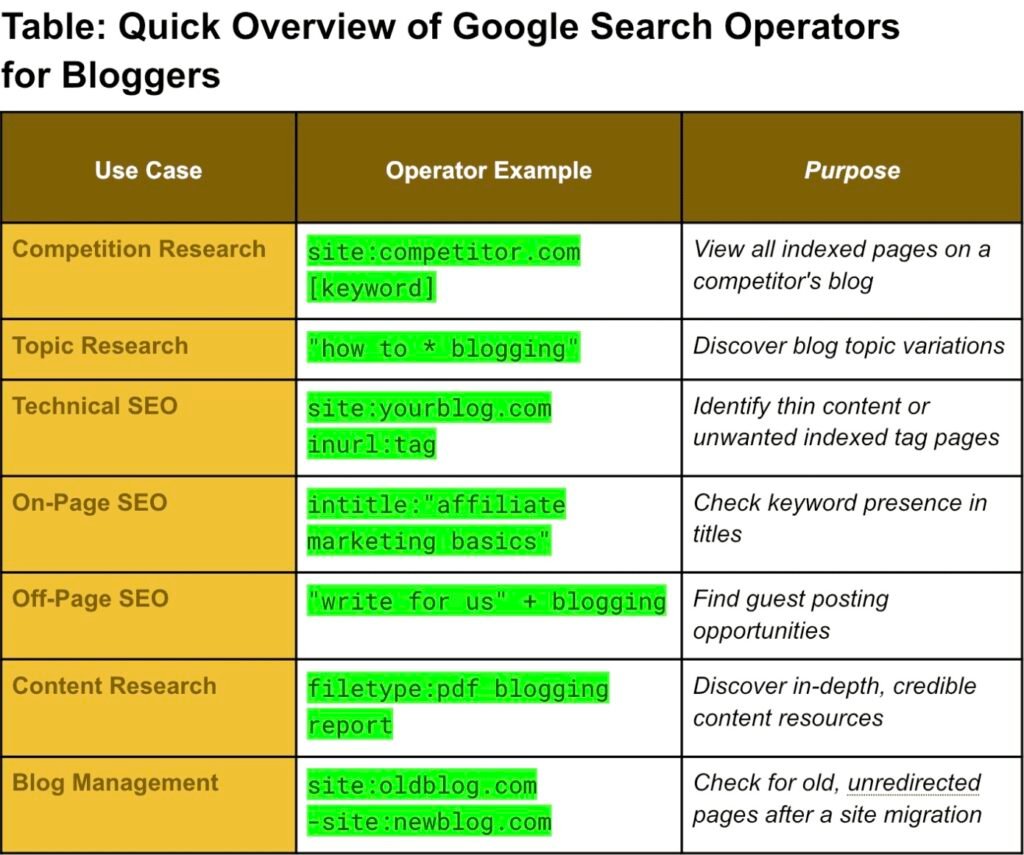Members' Preview
bloggers' KIT
Google Search Operators: The Free Method To Manage Competition And SEO
Paid tools can cost you much, so we brought Free methods that uses world’s most powerful tool – Google itself – to complete important blog tasks, like competition research, topic research, content research, SEO and more.
Disclaimer: In alignment with our business plan to minimize product costs for our customers, we may incorporate affiliate links.If a purchase or usage occurs through these links, we may receive compensation at no additional cost to the customer. Additionally, any discounts available through affiliate links are determined by the respective companies. If customer going to make a purchase, we encourage customers to verify any applicable discounts.
Google Search Operators
Template image: Click on it to download template
Introduction:
What if I told you that the most powerful blogging tool in the world is already at your fingertips — and it’s 100% free?
No, it’s not a fancy app or an expensive SEO subscription. It’s something you already use every day:
Google Search.
But here’s the truth most bloggers don’t know:
Google Search Operators can help you perform pro-level SEO tasks like:
Finding hidden keywords and blog ideas
Spying on your competitors’ content
Auditing your technical SEO issues
Discovering backlink opportunities
Tracking brand mentions and guest post targets
And even fact-checking or editing your content
…all without paying for tools like Ahrefs or BuzzSumo.
In this 7-part blog series, I’ll show you exactly how to use simple Google commands to grow, fix, and manage your blog like an expert.
Each section is broken down into real use cases like:
Competition Research
Topic Research
Technical SEO
On-Page SEO
Off-Page SEO
Content Research
Writing, Auditing & Management
You’ll get real examples, step-by-step guidance, and clever shortcuts — written in plain English, even if you’re just starting your blogging journey.
No more guessing. No more wasting hours.
Just free, smart, Google-powered blogging.
Let’s get started and unlock the true power of search — not just for browsing, but for building a blog that actually works.
🌟Important: We are going to take “Travel Accessories” as example niche to explain you how to use this trend analysis template. Let’s start 90-minutes 🕒 Trend Analysis.
Pro Tip: Collect all necessary resources (Bookmark it, download, buy or screenshot) before analysis, then start analysing ✅.
1. Competition Research:

Level: Beginner to Expert
Understanding what other blogs in your niche are doing is very important if you want to grow. Before writing your next blog post, it’s smart to look at what your competitors are already writing about. This will help you avoid repeating content and also help you find new gaps and opportunities.
With a few simple Google commands, you can:
- See all blog posts from a specific site
- Find websites similar to your competitors
- Check what topics other blogs are ranking for
- Look for content overlaps or missing areas
- See how active your competition is
Let’s explore how.
i. Beginner Operators – Start With the Basics

When you’re just starting out, these operators will help you get a feel for what other bloggers are doing in your space.
1. site: – Search content within a specific blog
What it does: Shows only results from a single website.
Example:
Search this in Google:
site:neilpatel.com blogging
You’ll see only results from Neil Patel’s blog that talk about blogging. It’s a quick way to study how someone successful talks about your niche.
2. related: – Discover similar blogs
What it does: Finds websites similar to the one you type.
Example:
related:smartpassiveincome.com
This might show other blogs like ProBlogger, BloggingWizard, or MakingSenseOfCents.
ii. Intermediate Operators – Look Deeper Into Your Niche

Now let’s go a little deeper. You can use combinations of search operators to find very useful insights.
3. "keyword" -site: – Exclude your own blog from results
What it does: Finds content with your keyword but removes your site from the list.
Example:"email marketing" -site:yourblog.com
This will show blog posts about email marketing from everywhere else — except your own blog.
You can also do this with your competitor’s brand name.
For example:"Marketing Course Guide" -site:marketingcourseguide.com
This helps you find brand mentions on other websites.
4. intitle: – Find titles using your keyword
What it does: Finds blog posts where your keyword is in the title.
Example:intitle:"blog traffic tips"
This is helpful to see how others title their posts about blog traffic. You can also use it on your competitor’s domain like:site:problogger.com intitle:"SEO"
You’ll see all SEO-related blog titles on that site.
iii. Advanced Operators – Content Gap Analysis
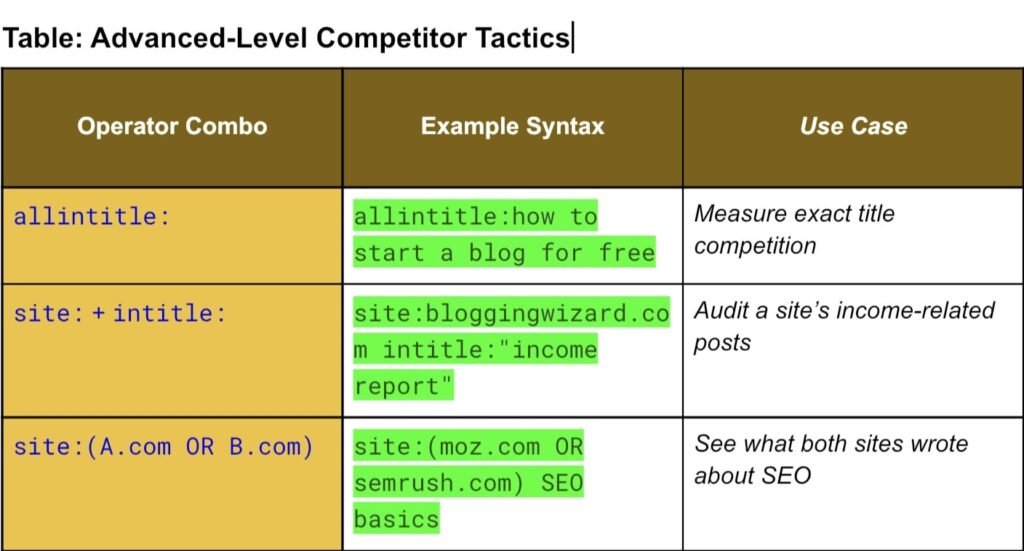
When you want to beat your competition, this is where things get exciting. You’ll now use multiple operators to uncover missing content gaps, keyword coverage, and more.
5. allintitle: – Search exact title phrases
What it does: Finds pages that have all your keywords in the title.
Example:
allintitle:how to monetize a blog
You can see how many other pages are targeting this phrase exactly. If the number is low, this keyword may be easier to rank for.
6. Combine site: + intitle:
What it does: Looks for very specific types of content on one site.
Example:
site:backlinko.com intitle:”SEO checklist”
You’ll find all pages where Backlinko talks about SEO checklists.
Try this too:
site:bloggingwizard.com (intitle:SEO OR intitle:income)
This shows all posts that have either “SEO” or “income” in the title.
iv. Expert Operators – Analyze Frequency, Context, and Intent

Let’s now step into expert territory.
7. after: / before: – Check how active a blog is
Example:
site:yourcompetitor.com after:2024-01-01 before:2025-01-01
This tells you how much content your competitor published in 2024. This is useful to measure how often they blog and stay active.
8. AROUND(X) – Find keyword connections
Example:
blogging AROUND(3) income
Google will show pages where “blogging” and “income” are within 3 words of each other. This helps you find blog posts that are closely related to both terms — like income reports or monetization guides.
Bonus Tip:

Bonus Tip: Combine With SEO Tools
Google search shows you what’s on a page, but not how well that page performs.
Here’s what pros do:
- Use Google to find competitors’ articles
(e.g., site:ahrefs.com intitle:”SEO checklist”) - Plug the URL into tools like Ahrefs, Ubersuggest, or SEMrush
- Check for:
- How much traffic it gets
- What keywords it ranks for
- How many backlinks it has
- Use this to create better content on your blog.
Summary for Competition Research
Whether you’re just starting your blogging journey or running an established blog, understanding what your competitors are doing is one of the smartest things you can do. With just a few Google searches using search operators, you can:
- Discover what topics others are covering
- Identify new content ideas
- Avoid repeating what’s already been done
- Improve your blogging strategy
Recommended Articles:
- How to Build a Blogging Strategy From Scratch Website
- Free Blogging Tools You Should Be Using in 2025 Website
- Beginner SEO for Bloggers: Step-by-Step Guide Website
Quote to Remember:
“Your competitors are your teachers — use Google to study their every move, and then outsmart them.”
Step 2 — Join Industry Associations
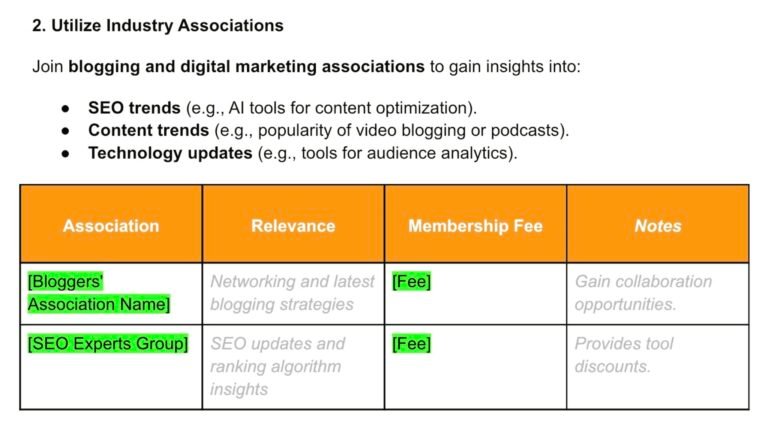
Why Bother Joining?
Associations gather exclusive insights you can’t easily find elsewhere:
Original reports.
Data you can use.
Opportunities to meet other bloggers or brands.
For Travel Accessories bloggers, look for travel-focused or blogging industry groups.
How to Decide Which Ones Are Worth Paying For
Start with free ones.
Only pay if the group offers things like:
Market research reports.
Exclusive webinars.
Opportunities for collaborations or backlinks.
Example Table
| Association | Relevance | Membership Fee | Notes |
|---|---|---|---|
| International Travel Goods Association (ITGA) | Access to travel gear market reports | $75/year | Great product ideas |
| Professional Travel Bloggers Association | Networking with travel influencers | Free | Collaboration chances |
Action Tip:
Set a reminder on your phone to review memberships once a year so you don’t forget about them.
Step 3 — Monitor Bestselling Books & Top Blogs
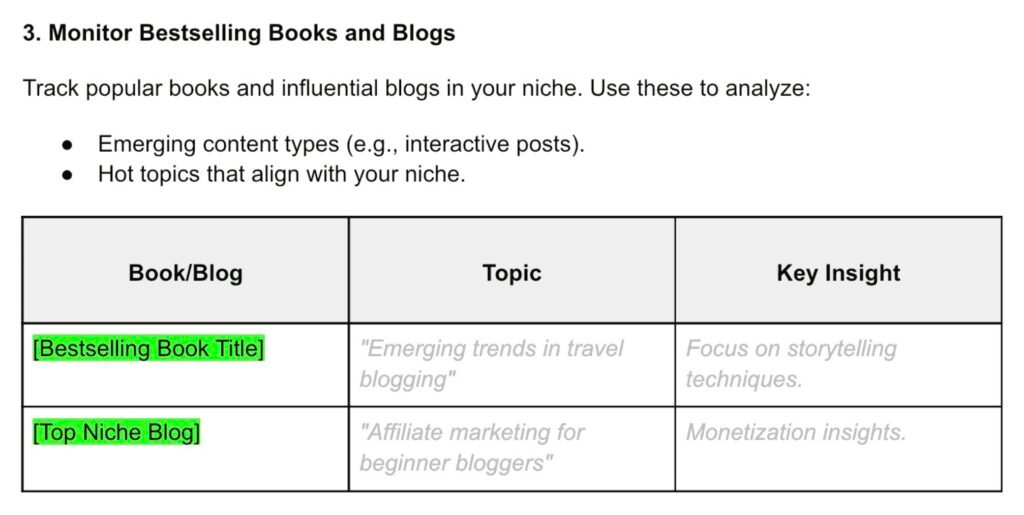
Why Books and Blogs?
They show what people are already paying for — which often hints at bigger trends.
How to Find Them Fast
Go to Amazon → “Books” → “Best Sellers” → search for “Travel.”
Use tools like Ahrefs Content Explorer to find blogs writing about upcoming trends.
Check lists like “Top 100 Travel Blogs” on sites like Feedspot.
Example Table
| Book/Blog | Topic | Key Insight |
|---|---|---|
| “The Travel Gear Bible” (Amazon Best Seller) | Travel essentials guide | Growing demand for lightweight gear |
| Nomadic Matt (Blog) | Budget travel hacks | Readers love affordable gear suggestions |
How to Pull Useful Insights
Amazon Reviews: Read 4-star and 2-star reviews to see what people love and hate.
Blog Comments: Look for questions or repeated frustrations.
Save juicy quotes — they can inspire blog titles or product ideas!
Step 4 — Check Government and Institutional Data
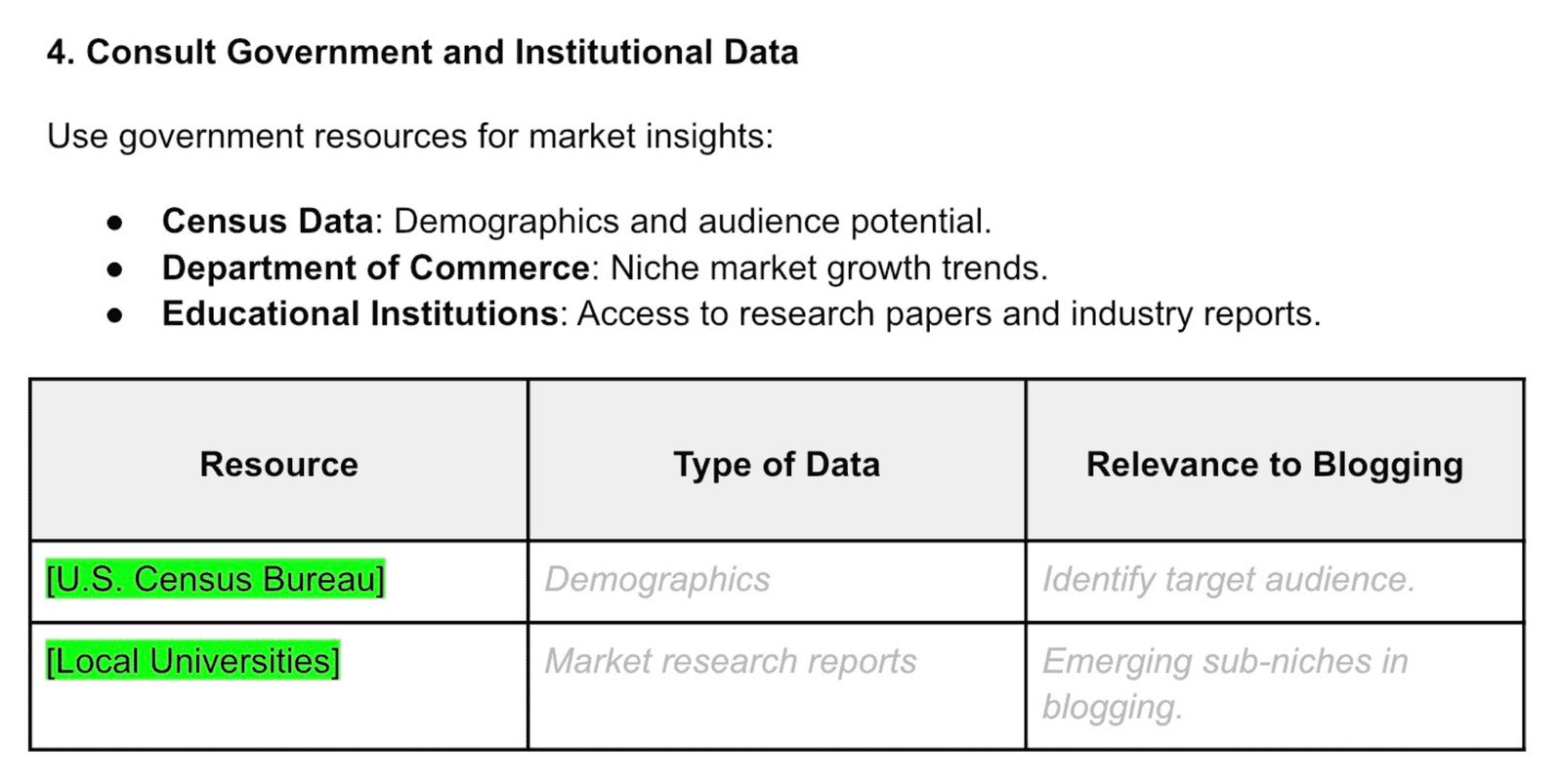
What Kind of Data?
Official statistics show who’s traveling, what they buy, and what’s changing.
Where to Find It
U.S. Census Bureau → “Travel spending by age group.”
Eurostat → “Tourism statistics.”
University Reports → Search “[travel habits] site:.edu PDF” on Google.
Example Table
| Resource | Type of Data | Relevance |
|---|---|---|
| U.S. Census Bureau | Travel spending patterns | Shows if people are spending more on accessories |
| Local University Research Center | Tourism behavior study | Reveals emerging needs like sustainable products |
Pro Tip:
Government reports often include free charts you can reuse (just give proper credit!).
Step 5 — Learn from Tool Companies, Creators, and Hosting Providers
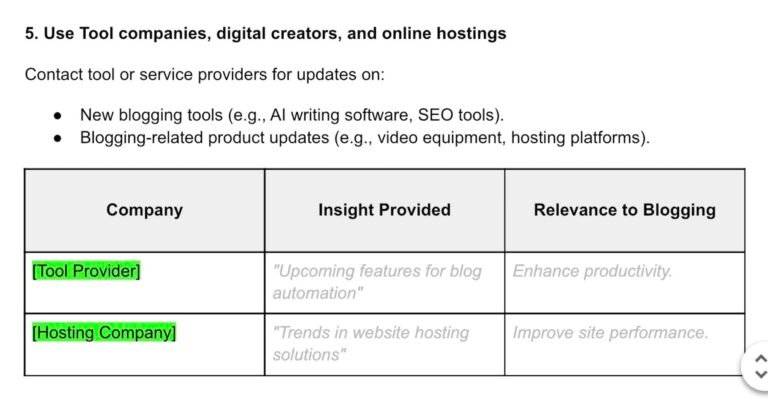
What to Ask
New feature rollouts (“What’s launching next?”).
Customer data insights (“Which travel gear is selling fastest?”).
This works especially if you affiliate with them!
Example Table
| Company | Insight Provided | Relevance |
|---|---|---|
| Shopify | Most popular travel gear stores by category | Spot hot product categories |
| Bluehost (Hosting) | Blog traffic benchmarks by industry | Know how your travel blog compares |
Action Tip:
Save all company contact emails in a spreadsheet for future collaborations or questions.
Step 6 — Subscribe to Newsletters and Trade Magazines
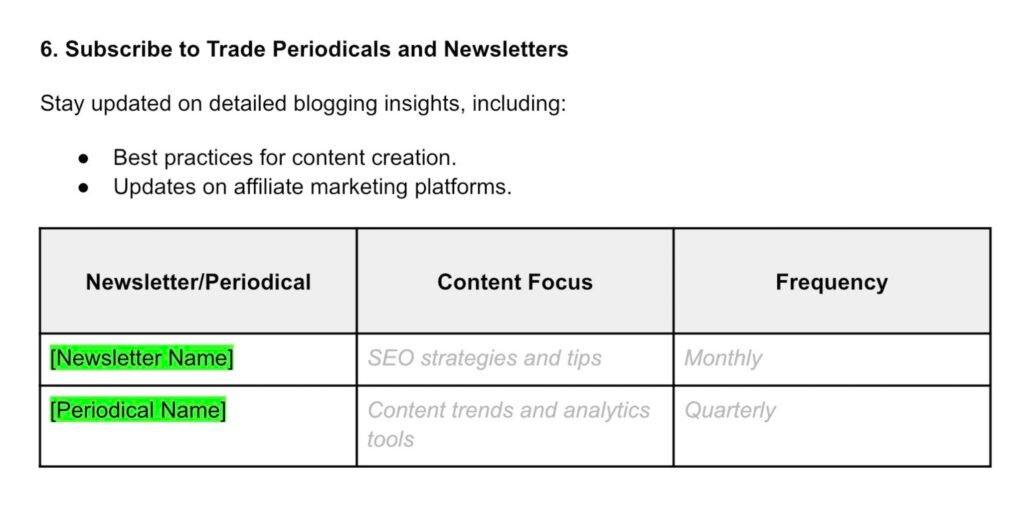
Why?
Newsletters filter trends for you.
You just have to open your inbox!
Where to Find Good Ones
Use a second Gmail just for newsletters.
Subscribe to both travel gear industry and blogging tips newsletters.
Example Table
| Newsletter/Periodical | Content Focus | Frequency |
|---|---|---|
| Travel Goods Showcase | New travel gear launches | Monthly |
| Creator Economy Newsletter | Blogging trends, viral formats | Weekly |
Shortcut:
Set one day per week (like Sunday) to review all your newsletters quickly.
Step 7 — Attend Industry Events and Trade Shows
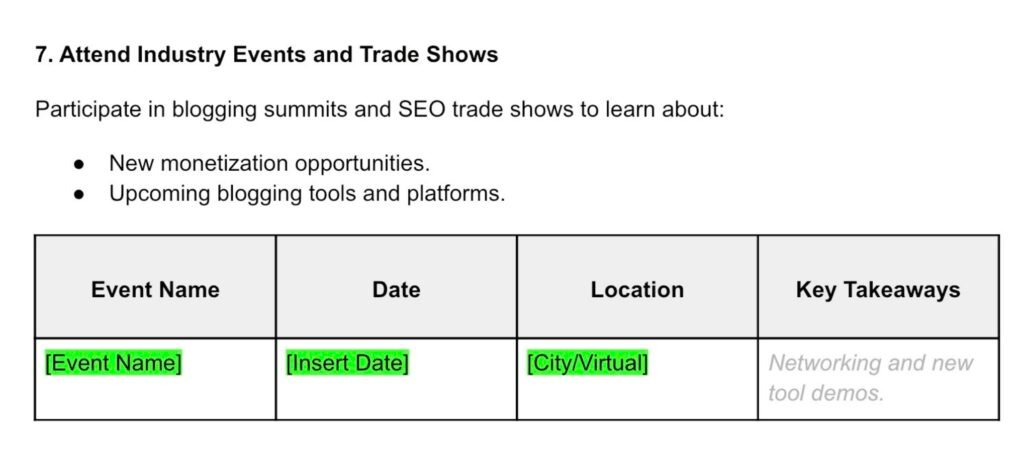
Why?
Events are where trends are born and deals are made.
You don’t even have to leave your house — virtual summits count too!
Example Table
| Event Name | Date | Location | Key Takeaways |
|---|---|---|---|
| Outdoor Retailer Expo | June 2025 | Denver, CO | New travel backpacks & accessories |
| TravelCon (Virtual) | September 2025 | Online | Blog monetization workshops |
Pro Tip:
After any event, immediately write down 3 action steps you can apply to your blog.
Step 8 — Read Industry Journals and Magazines
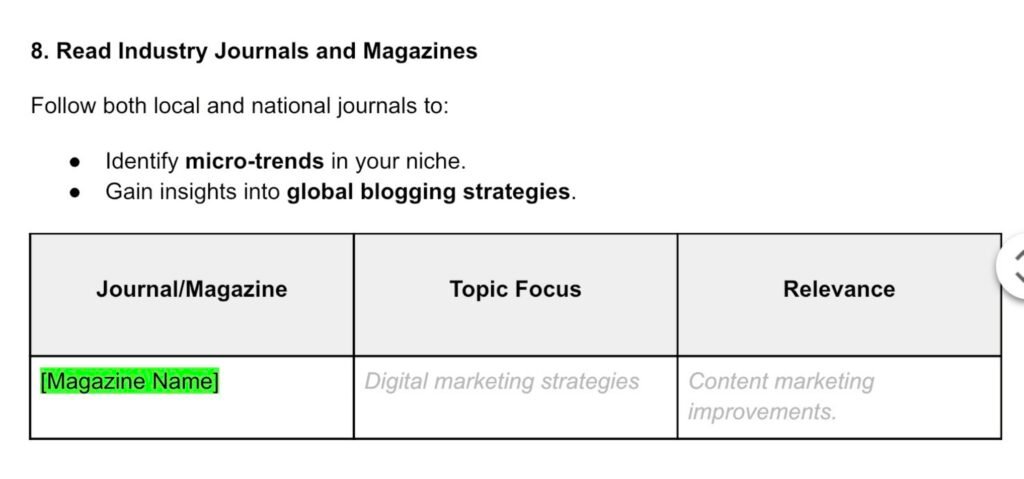
Why?
Journals dig deeper than blogs.
They offer real research, not just opinions.
Example Table
| Journal/Magazine | Topic Focus | Relevance |
|---|---|---|
| Journal of Travel Research | Academic travel trends | Insight into long-term behavior shifts |
| Travel + Leisure Magazine | Luxury travel gear reviews | Product review inspiration |
Budget Tip:
Even reading summaries of journal articles can give you a huge advantage.
“When” Should You Use Trend Analysis Template

When Should You Use This Template?
1. Starting a New Blog: Kick off strong!
Use this template to spot hot new niches, popular topics, and hidden opportunities before you even write your first post.
Example: Discover the booming interest in AI content tools for a future-ready tech blog.
2. Planning Your Content Calendar: Don’t just post — post smart.
This template helps you find trending topics that will bring in more clicks, shares, and followers.
Example: Adding short-form videos to your blog because everyone’s loving quick, snackable content.
3. Noticing a Drop in Traffic or Income: It’s time for a course correction.
Use the template to quickly spot what’s changing in your audience’s habits — and what you should pivot to next.
Example: Shifting from long articles to podcast-style posts if that’s what your readers now prefer.
4. Updating How You Make Money: New monetization ideas?
Before you dive in, use this template to find fast-growing niches and better products or partners to maximize your earnings.
Example: Finding affiliate programs tied to trending products in your niche.
5. Doing Regular Blog Check-Ups: Stay ahead!
A quick review every few months with this template ensures your blog stays fresh, keeps growing, and meets your readers’ needs as the market shifts.
“Why” Should You Use Trend Analysis Template

Why Should You Use This Template?
1. Stay Ahead of the Competition:
Spot trends early and stay one step ahead. You’ll keep your blog relevant, exciting, and competitive in any niche.
2. Create Content Your Audience Actually Loves:
No more guesswork. Give your readers exactly what they want and watch your clicks, comments, and shares skyrocket.
3. Make More Money, Faster:
Use trend insights to focus on high-growth areas, land better affiliate deals, and boost your sponsored post income.
4. Save Time and Plan Smarter:
This template gives you a simple roadmap for planning content, so you spend less time thinking and more time growing.
5. Build a Strong Reputation:
When you consistently create trend-savvy content, you’ll be seen as an industry leader — someone readers and brands trust and follow.

